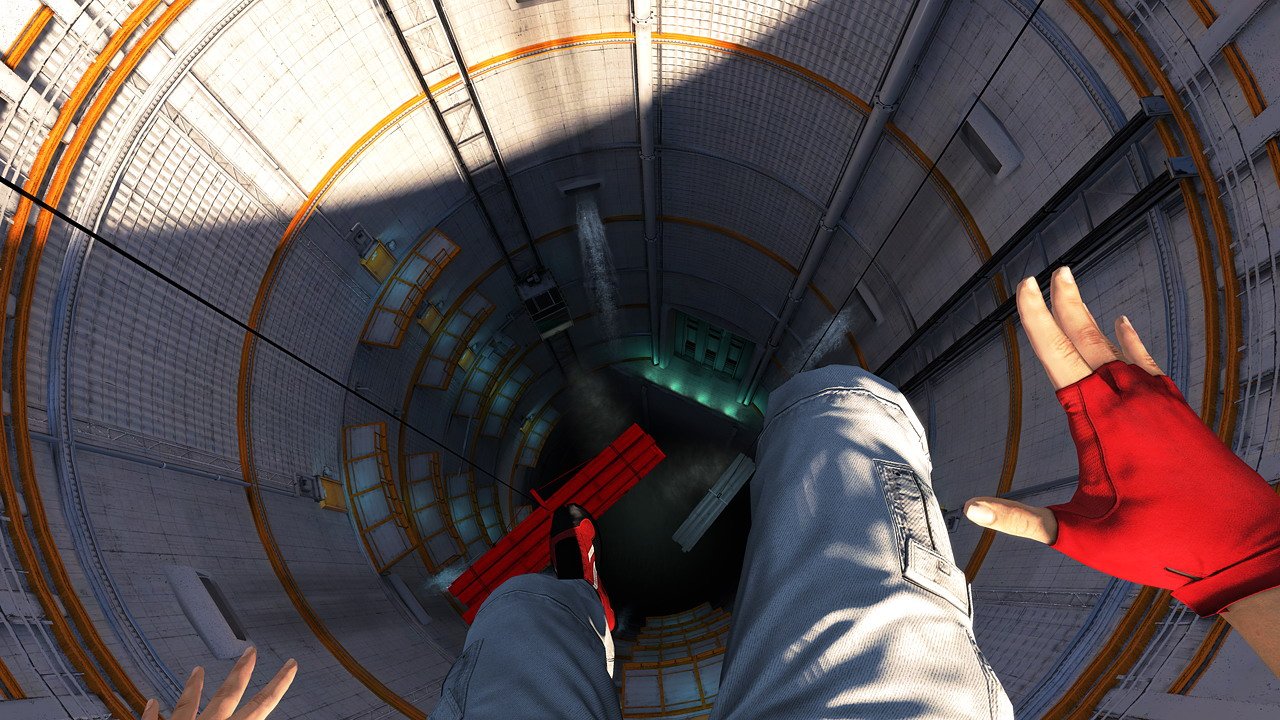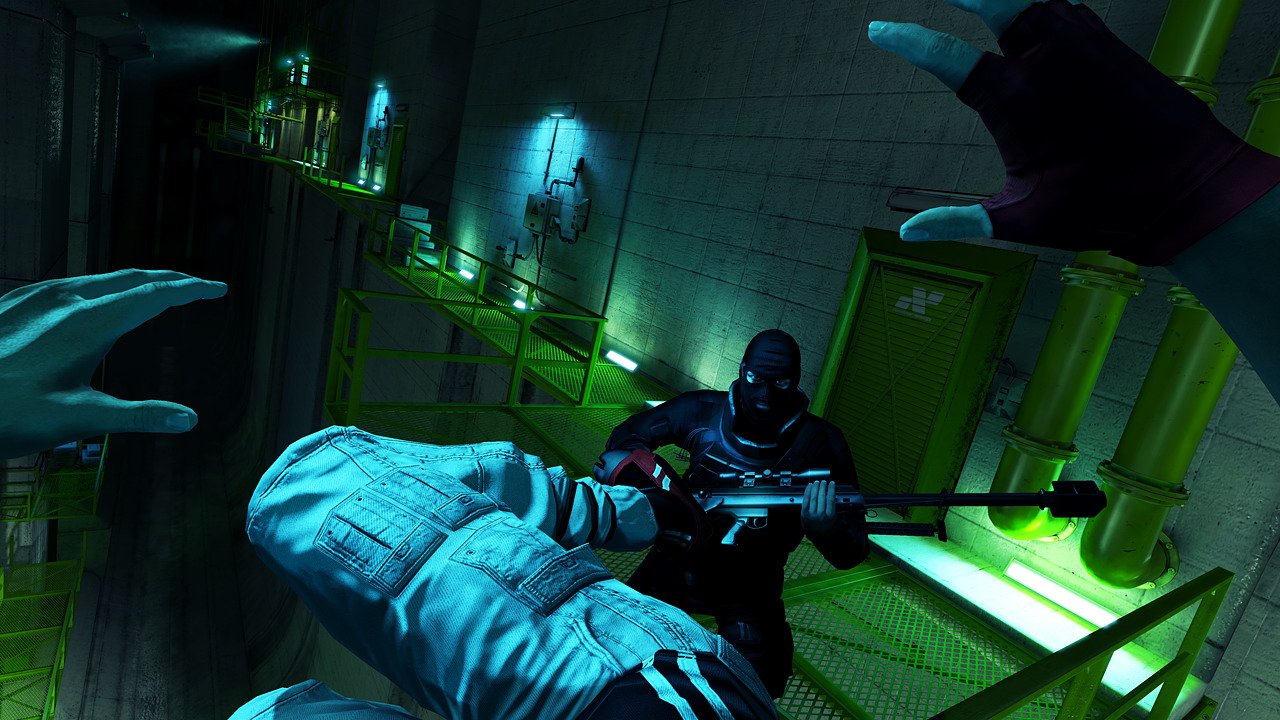Mirror's Edge Updated Impressions
How do you make daring first-person rooftop traversals at high speed while under a hail of gunfire? EA DICE's demo lays it out for us.
When EA DICE announced Mirror's Edge, senior producer Owen O'Brien hinted that it would "change the way that players are able to move in first person." Since then, we've seen screens and videos emerge showing a shining modern metropolis framed by the red gloves and shoes of an agile runner named Faith. Running across rooftops and makeing nausea-inducing leaps with grace and fluidity, Faith embodied this new take on first-person movement. Now, a year later, we've got the first look at the control scheme for Mirror's Edge and had a chance to watch O'Brien take down armed guards and make--or not quite make--those dramatic free running jumps.
The demo began with Faith on top of the white rooftops shown in the first official trailer. As she ran around, her signature red fingerless gloves flitted in and out of the frame. Looking down, we also saw her cargo pants along with her red and black shoes moving apace. Much like the visible guns in first-person shooters, Faith's arms and legs are the tools that enable her to accomplish her goals, so seeing them is a nice visual touch. Beyond the aesthetic appeal, the logistical utility of being able to see her feet seemed to come in handy as she faced that first, vertiginous leap.

Faith has two speeds: run and sprint. When prepping for the jump, O'Brien practiced sprinting, and both the motion blur and the sounds of heavier breathing helped convey an increased sense of speed. As Faith approached the ledge, O'Brien gave us a quick explanation about the control system in Mirror's Edge. There are no jump or crouch buttons; instead, there are up and down buttons. The up button will make Faith jump as she approaches gaps or mantle as she approaches obstacles, while the down button will make her slide underneath a barrier or parachute roll at the end of a long jump. These contextual controls will hopefully make Faith's acrobatics easier to execute and allow players to move through the environments more fluidly.
O'Brien proceeded to walk us through the long leap and subsequent fence mantling shown early in the official trailer. Upon landing the jump after a few missed tries, he explained the concept of a heavy landing versus a soft landing. Hitting the down button at the end of a jump will make Faith roll into a soft landing, preserving her momentum and allowing her to continue running at speed. If you mistime that press, she'll land with a hard oomph, lose momentum, and be vulnerable to a sniper's bullet. Preserving speed will be key to avoiding danger and completing missions. The challenge of keeping your speed up will lie in chaining together jumps, landings, and slides while navigating quickly through the environments.
When you run into a tricky spot, you can use Faith's version of bullet time to slow things down temporarily. The only heads-up display element--a tiny reticle in the middle of the screen--indicates when this ability is available. Faith's runner's vision can also aid in your speedy navigation. This sense--which can be toggled on and off--will highlight key elements in red as you approach them so you can pick out a path on the fly. You'll also be guided by a dispatcher named Mercury, an underground ally who will speak through a small receiver in your ear and provide information about your environment, as well as the enemies you might come across or who might be searching for you.
Given the controlling, dystopian society of Mirror's Edge, it's no surprise that there are enemies aplenty waiting to gun you down. Even though Faith is unarmed, she's far from weaponless. EA DICE has given her a strong command of wing chun, a martial art purportedly developed by a Buddhist nun that focuses on close, fast combat and flowing energy. In keeping with the contextual control scheme, there is only one button for combat that, when combined with other buttons like up and down, can produce a number of varied attacks. We watched as Faith sprinted toward an enemy, slid to avoid gunfire, kicked his legs out from under him, and knocked him out. She then leveled another by jumping off a wall and kicking him across the face. In her final encounter, Faith disarmed her third enemy, shot him with his own weapon, dropped it, and ran. Weapons are a temporary power-up in Mirror's Edge, encumbrances that are automatically discarded when the ammo runs out, providing you don't ditch them sooner.
To round out the demo, O'Brien took Faith to a vast underground area inspired by the cavernous storm drains built underneath Tokyo to accommodate tsunamis. Here, we saw Faith move through vertical space in a nice contrast to the largely horizontal rooftop action. In one particularly neat maneuver, O'Brien used the 180-degree turn button to perform a wall jump--up, 180, up--and Faith grabbed onto a ladder that previously seemed out of reach.
We left the demo impressed with how adeptly Faith managed maneuvers that seem ill-suited to first-person gameplay. O'Brien was quick to clarify that while he wants it to be easy for players to do cool things, it will be a much tougher challenge to chain many cool things together to accomplish spectacular stunts. Players looking to try some daring first-person platforming can look for Mirror's Edge on the Xbox 360, PlayStation 3, and PC this holiday season. We'll be sure to keep you posted with the latest on this exciting game from EA DICE.
Got a news tip or want to contact us directly? Email news@gamespot.com

Join the conversation